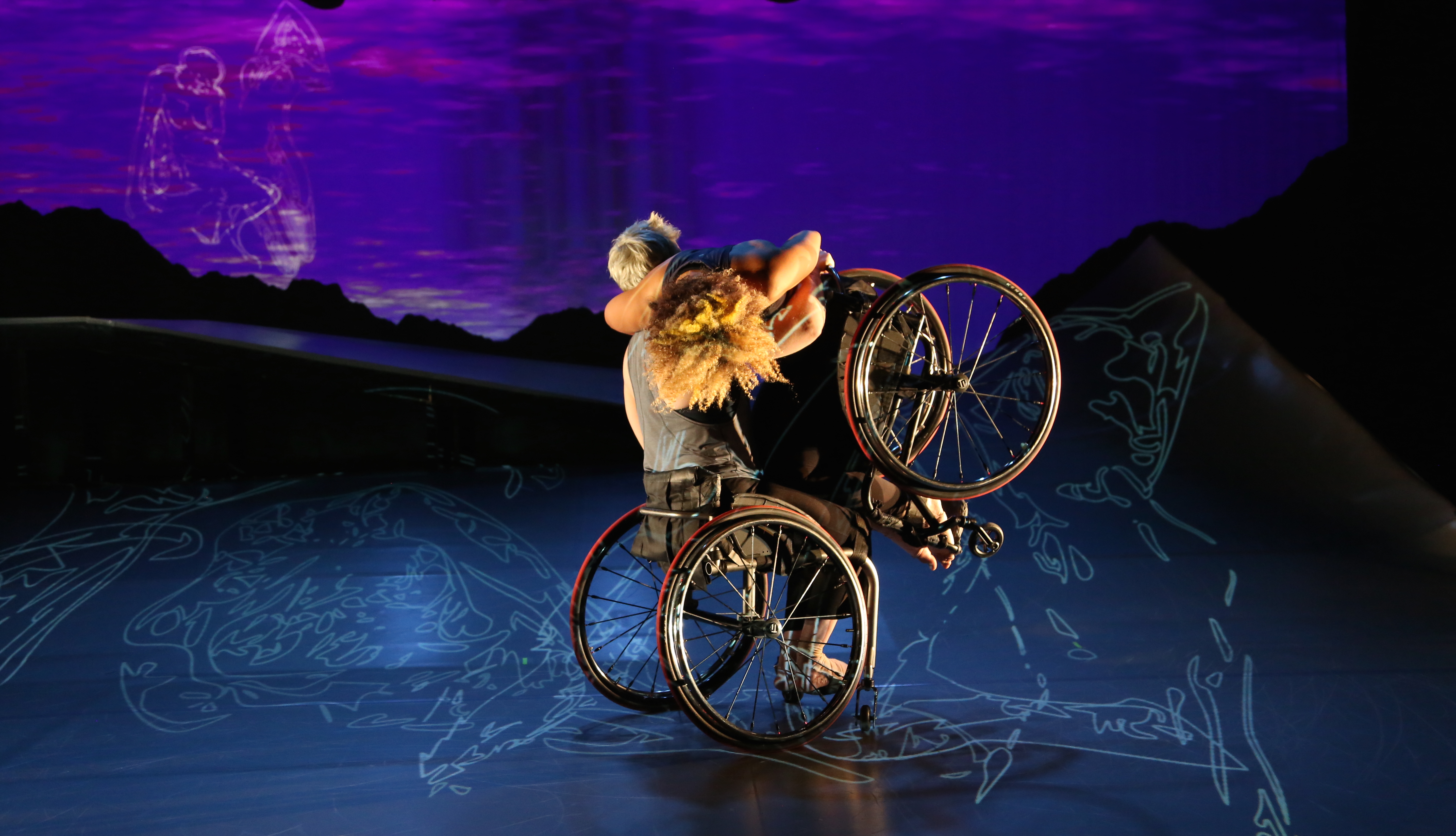The Women Building a New Art Form in the World of Dance
Credit to Author: Emily Nonko| Date: Mon, 07 Jan 2019 20:38:45 +0000
There’s a saying among modern dancers that your first partner is the floor. But for Alice Sheppard and Laurel Lawson, who have made careers of pushing the art form in different directions, the floor wouldn’t do. They found their home dancing on a ramp.
Their ramp isn’t just any ramp. Their ramp towers at six feet and sprawls 24 by 15 feet across a stage. From a platform it slopes downward, then dramatically upward into a tight peak, before gently curving toward the ground.
Sheppard and Lawson will at turns refer to the ramp as magic, as a living thing, as their third dance partner. “It signifies a particular joy of wheeled movement,” Lawson told me over the phone. A week earlier I had watched her and Sheppard, both wheelchair users, slowly coax the ramp to life. Warming up for a performance at the Curtis R. Priem Experimental Media and Performing Arts Center (EMPAC) in Troy, New York, they moved in and out of their chairs to stretch, slide and shimmy across its expanse. A few hours later, they’d put on glimmery gray bodysuits—their “armor,” as they describe it—to perform as the mythical figures Andromeda and Venus in an interracial, queer love story they call DESCENT.
A good artist is said to copy, and a great artist to steal, but what Sheppard and Lawson are doing could barely fit into either of those categories. Rather, DESCENT is the premiere work of the Kinetic Light collaborative, founded by Sheppard two years ago with the intention to create dance she realized that, as an artist with a disability, no one would choreograph for her, and furthermore, that a viewer might never have conceived of existing. “In this field,” Sheppard said, “I find audience members go to a show and find the things they imagined about disability aren’t the case.”
Kinetic Light embraces this newness, which can be a paradigm shift for able-bodied audience members, and just plain affirming for disabled audience members. Her goal, however, is moving beyond questions of ability and toward culture and aesthetics—a radical shift now happening in the field of disability arts, which has often seen itself defined externally by that classification alone.
“Laurel and Alice are actually pioneering this newest wave I’m seeing in disability arts,” said Carrie Sandahl, head of the program on disability art, culture and humanities at University of Illinois at Chicago. That category, according to Sandahl, emerged in the 1970s and refers to art by people with disabilities that reflects a disability experience. Over the years, the work has engaged political issues like accessibility rights; it challenges stereotypes; and shines a light on the diverse, lived experiences of people whose narratives have often been shifted to the background.
But this new wave “is a consideration of the aesthetic possibilities of disability,” explained Sandahl. “It’s not about adaptation or accommodation. It’s about how unique bodies, minds, senses and phenomenological experiences of disability and impairment—along with the political aspects and intersectional identities—can create new work.”
Tackling the unknown to create something new is kind of Sheppard’s thing. “I was immediately impressed by her ambitions,” said Michael Maag, the third and final member of Kinetic Light, and the lighting and projection designer who is also a wheelchair user. In his early encounters with the ramp, he wasn’t sure how Sheppard and Lawson would pull off dancing, given the uniqueness of the inclined plane. Sheppard had envisioned the ramp as a work of art and a movement partner—the stark opposite to a structural access ramp. “Coming from the technical side there’s concern, having to say physics doesn’t work that way,” Maag said. “With Alice, there’s no concern for reality… what’s important is the idea of the art.”
Early experimentation between Sheppard, Lawson, Maag and the ramp has paid off. The collaborative has been recognized in the arts world for centering accessibility, and Kinetic Light is now preparing to bring DESCENT across the country for its first tour. It’s an opportunity to further push the work outside the “arts bubble,” as Sheppard calls it, to bring matters of access, equity and intersectionality to a larger audience. “It’s not just three people making art anymore,” said Sheppard. “It’s time for us to build.”
Thinking about the journey, she added, “I couldn’t have imagined a life that is sharing this work and creating more of it. I have an unlikely life, and here it is.”

Over the phone in November, Sheppard asked about my experience during her EMPAC performance. I explained how arresting a friend and I, both able-bodied, had found it. For me, it was powerful to see the pair perform knowing the work it’d taken to get there. For my guest, who knew very little about Kinetic Light, her understanding of the disabled body had changed.
“Dance is a visceral experience of the body—and we all have bodies,” Sheppard told me. “We all know how to inhabit a physical presence. It made some kind of sense to your friend, and it made sense to you.”
At the finale of DESCENT, Sheppard, out of her wheelchair, makes the climb to the peak of the ramp. Her back is to the audience, her head rising just above the massive structure and enveloped by Magg’s projection of a milky sky. Lawson, erect in her chair, builds up speed to move toward Sheppard, rolling up and hovering just over her body.
The two of them, their bodies and a wheelchair in an embrace atop the ramp, hold still before the lights go out. From the audience, it looks as if they’re ready to take off in flight.
Sign up for our newsletter to get the best of VICE delivered to your inbox daily.
Follow Emily Nonko on Twitter.
This article originally appeared on VICE US.